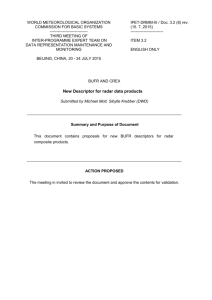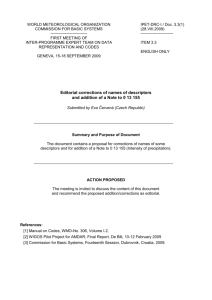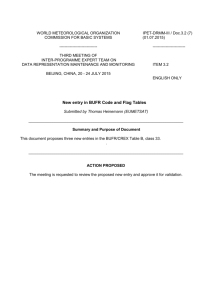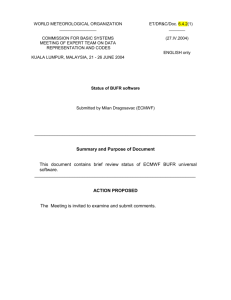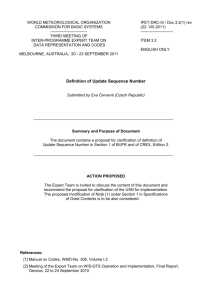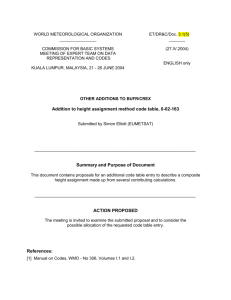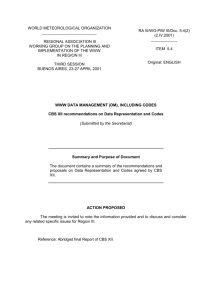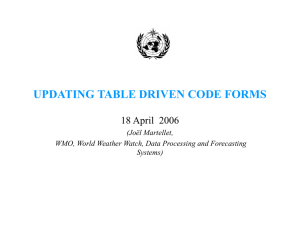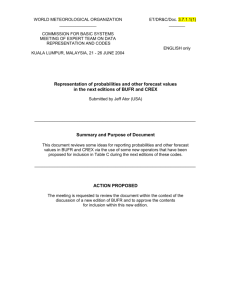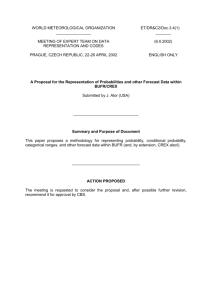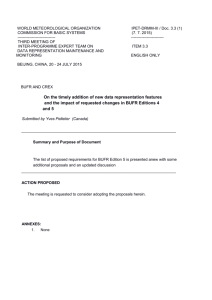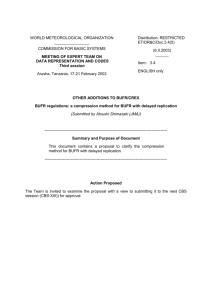Amendments to B/C Regulations
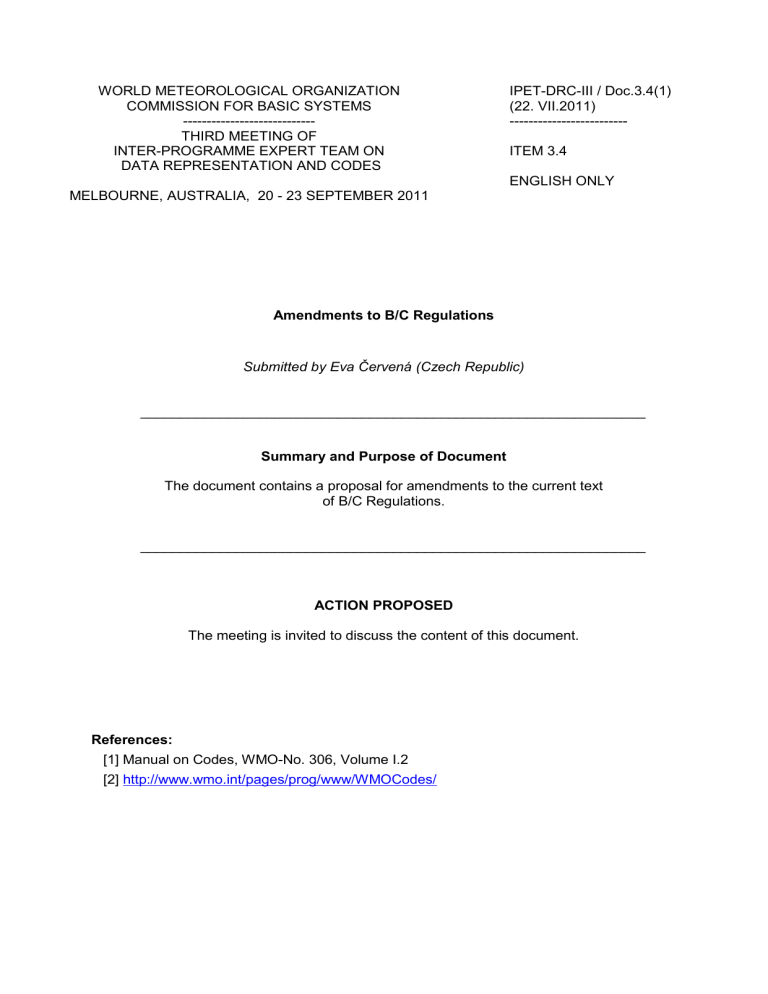
WORLD METEOROLOGICAL ORGANIZATION
COMMISSION FOR BASIC SYSTEMS
----------------------------
THIRD MEETING OF
INTER-PROGRAMME EXPERT TEAM ON
DATA REPRESENTATION AND CODES
MELBOURNE, AUSTRALIA, 20 - 23 SEPTEMBER 2011
Amendments to B/C Regulations
IPET-DRC-III / Doc.3.4(1)
(22. VII.2011)
-------------------------
ITEM 3.4
ENGLISH ONLY
Submitted by Eva Červená (Czech Republic)
________________________________________________________________
Summary and Purpose of Document
The document contains a proposal for amendments to the current text of B/C Regulations.
________________________________________________________________
ACTION PROPOSED
The meeting is invited to discuss the content of this document.
References:
[1] Manual on Codes, WMO-No. 306, Volume I.2
[2] http://www.wmo.int/pages/prog/www/WMOCodes/
1. Background
Regulations for Reporting Traditional data in TDCF (B/C Regulations) are included in Part C of the Manual on Codes. The submitted document contains proposals for additions or modifications of the existing text of some B/C Regulations.
2. Entries required in Section 1 of BUFR
In Section 1 of BUFR edition 4, the entry Second is required. It is proposed to add a new line:
- second (= 0) (1) preceding the Notes in regulations B/C 1.1.1, B/C 5.1.1, B/C 10.1.1, B/C 20.1.1, B/C 25.1.1 and B/C 26.1.1
- second (= 0) (1), (3) preceding the Notes in regulations B/C 30.1.1 and B/C 32.1.1
.
3. Regulation B/C 1.9.6.1.2 Squall
The existing representation of dangerous phenomena within 3 02 066 for RA VI regional reporting practices allows reporting the occurrence of a squall, but not its type.
Alternative A
B/C 1.9.6.1.2 Squall
Squalls between observation times shall be reported using Flag table 0 20 023 (bit No.2 set to 1). The nature and/or type of the squall shall be reported using code figures 50 to
59 of the following entry Special phenomena 0 20 063 (see Note).
Occurrence of the phenomenon (Flag table 0 20 027) shall be specified by setting bit No. 3 to 1 (In time period for past weather). True direction from which the squall approaches the station (0
20 054) shall be reported in degrees true.
Note:
Special phenomena 0 20 063 was added into 3 02 066 with introduction of Version 16 of
WMO FM 94 BUFR Tables.
Alternative B
B/C 1.9.6.1.2 Squall
Squalls between observation times shall be reported using Flag table 0 20 023 (bit No.2 set to 1). Occurrence of the phenomenon (Flag table 0 20 027) shall be specified by setting bit No. 3 to 1 (In time period for past weather). True direction from which the squall approaches the station (0 20 054) shall be reported in degrees true. The nature and/or type of the squall may be reported using code figures 50 to 59 of Special phenomena 0 20 063; in this case, 3 07 086 should be supplemented by 0 04 024 (set to time period for past weather) and by 0 20 063.
Alternative C
B/C 1.9.6.1.2 Squall
Squalls between observation times shall be reported using Flag table 0 20 023 (bit No.2 set to 1). Occurrence of the phenomenon (Flag table 0 20 027) shall be specified by setting bit No. 3 to 1 (In time period for past weather). True direction from which the squall approaches the station (0 20 054) shall be reported in degrees true. If more detailed information on occurrence and the nature and/or type of the squall is to be reported, 3 07 086 should be supplemented by two consecutive 0 04 024, by Special phenomena 0 20 063 (using code figures 50 to 59) and by 0 20 054 (True direction from which the squall approaches the station).
4. B/C 25 - General
General (current text)
A BUFR (or CREX) message should be sent when the 100 hPa level is reached. In any case, a BUFR (or CREX) message shall be produced when the sounding is completed containing data from the entire sounding.
If high resolution data are reported, only one BUFR message should be sent when the
100 hPa level is reached and only one BUFR message shall be produced when the sounding is completed, provided that all standard and significant levels are properly identified in compliance with the relevant B/C 25 Regulations.
The following modification is proposed:
General
A BUFR (or CREX) message shall be sent when the 100 hPa level is reached.
Subsequently , a BUFR (or CREX) message shall be produced when the sounding is completed containing data from the entire sounding . If the sounding is terminated below
100 hPa level, only the later message shall be produced.
If high resolution data are reported, only one BUFR message shall be sent when the 100 hPa level is reached and only one BUFR message shall be produced when the sounding is completed, provided that all standard and significant levels are properly identified in compliance with the relevant B/C 25 Regulations.
